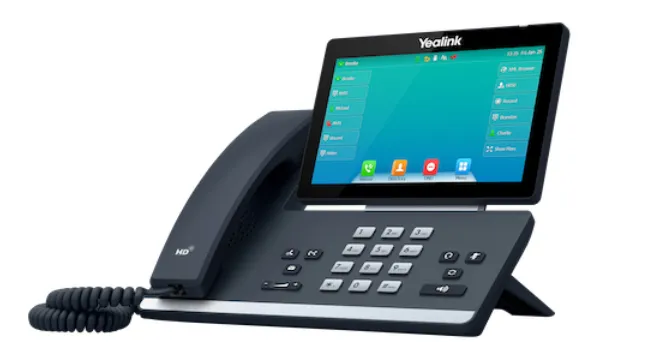
Softphone
When it comes to choosing a phone system for your business, one of the biggest decisions you’ll face is whether to use softphones or deskphones. Both options allow your team to make and receive calls — but how they do it (and what they cost) can vary significantly.
Softphone vs Deskphone: Which One Is Right for Your Business?
When it comes to choosing a phone system for your business, one of the biggest decisions you’ll face is whether to use softphones or deskphones.
Both options allow your team to make and receive calls — but how they do it (and what they cost) can vary significantly.
So, which one is better for your business? Let’s break it down.
What is a Deskphone?
A deskphone is a traditional-looking handset that sits on your desk and plugs into your network via Ethernet or connects via VoIP.
While it may look similar to old-school landlines, most deskphones today use internet-based phone systems (like 3CX or Microsoft Teams Calling).
Key features:
• Physical handset, speaker, buttons, and often a display screen
• Requires a wired connection (Ethernet or power-over-Ethernet)
• Typically plugged into a VoIP PBX or cloud-hosted phone system
Ideal for:
• Reception desks
• Staff who prefer tactile keypads or want to avoid using computers for calls
• Offices with stable desk setups
What is a Softphone?
A softphone is a software-based phone — typically an app that runs on your computer, laptop, or mobile device.
It uses your internet connection and headset (or built-in microphone/speakers) to handle calls.
Softphones are popular in modern workplaces because they’re cost-effective, portable, and easy to set up.
Key features:
- Works on Windows, Mac, iOS, Android (e.g., 3CX, Microsoft Teams)
- No physical handset required — just a headset or earbuds
- Integrates with CRM, calendars, and collaboration tools
Ideal for:
- Remote workers or hybrid teams
- Businesses that want flexibility and scalability
- Teams that already live in Microsoft 365 or Google Workspace

Feature Comparison: Deskphone vs Softphone
Choosing between softphones and deskphones isn’t just about preference — it’s about how each option supports the way your team works, and how they fit into your broader IT strategy.
Here’s a detailed breakdown of the key features to consider:


Feature
Deskphone
Softphone
Hardware Requirements
Requires a physical handset (e.g., Yealink, Cisco, Polycom) and often a PoE switch
Only needs a compatible device (PC, laptop, tablet, mobile) and headset or earbuds
Portability
Fixed to a desk
Highly portable — log in from anywhere with internet
Setup Time
May require technician or manual provisioning
Fast deployment — install the app and sign in
Call Quality
Typically excellent if wired and network is stable
Dependent on device/ network quality (internet speed dependant)
Power Dependency
Requires constant power; can use PoE (Power over Ethernet)
Runs off device battery; may drain laptops or mobiles during long calls
User Experience
Familiar and consistent; preferred by those who dislike headset calling
Modern and flexible; integrates with software tools and workflows
Multi-Device Support
Supports multiple devices per user (e.g. deskphone, mobile app, softphone) — all linked to the same extension.
One account, multiple devices — switch between laptop and mobile easily
App Integration
Minimal or none — some high-end models offer contacts/calendar sync
Easily integrates with calendars, CRMs, chat tools (e.g., Microsoft Teams, HubSpot)
Cost
Higher upfront cost per user ($150–$500+ per handset)
Lower upfront cost (free apps, BYO device); may require software license
Ideal Use Cases
Reception desks, call centres, healthcare, shared workstations
Remote teams, mobile workers, sales staff, BYOD-friendly offices
What This Means for You
Deskphones offer stability, tactile feedback, and a dedicated device — perfect for high-call-volume roles or staff who dislike using their PC or phone for calls.
Softphones offer agility, remote access, and a lower cost of ownership — ideal for hybrid teams, flexible work, or startups wanting to scale fast.
Most modern VoIP platforms (like 3CX or Teams) let you mix and match — so you can give each team member the option that suits them best.
Not sure what setup works for your staff?
We’ll help you build a solution that balances performance, cost, and flexibility.
Other Considerations
Before you commit to softphones, deskphones, or a hybrid setup, it’s worth considering the unique needs of Australian small and medium businesses — especially when it comes to infrastructure, work styles, and security.
Here are some of the most important factors to weigh up:
Internet Reliability
Both softphones and deskphones rely on VoIP (Voice over IP), meaning a strong, stable internet connection is non-negotiable.
If your office is in a metro area with a high-speed fibre connection, either option will work well. But for rural or fringe metro locations, you may face dropouts or jitter that impact call quality.
✅ Tip: In lower-coverage areas, consider 4G/5G backup routers or prioritise deskphones with QoS-enabled networks to maintain consistency.
NBN Compatibility (and Why NBNEE Might Be Worth It)
VoIP systems — including those used for both softphones and deskphones — work reliably on the NBN, but performance can vary based on your connection type.
Not all NBN is created equal:
FTTP (Fibre to the Premises) and HFC (Hybrid Fibre Coaxial) deliver the best results for VoIP. These offer fast speeds and low latency, making them ideal for softphone-heavy environments or larger call volumes.
FTTN (Fibre to the Node) or Fixed Wireless connections may still work but are more prone to jitter, lag, or call dropouts — especially during peak hours.
In fringe or regional areas, even deskphones can struggle on lower-grade NBN without careful network tuning or QoS.
💡 NBNEE (NBN Enterprise Ethernet) is a premium-grade business fibre service that delivers guaranteed speeds, symmetrical upload/download rates, and 24/7 enterprise support.
If your business handles high call volumes, video conferencing, or remote staff using softphones, NBNEE might be worth exploring — especially if uptime and call clarity are mission-critical.
✅ Tip: Ask your ISP or IT provider about whether NBNEE is available at your address.
💡Speed may vary based on your location and internet plan.
Hybrid & Remote Teams
Modern work environments are flexible — and your phone system should be too.
If your team regularly works from home, switches locations, or hotdesks, softphones are a clear winner.
There’s no physical hardware to lug around or reconfigure — just log in from any device and start calling.
In contrast, deskphones are better suited for permanent desk setups or shared spaces like reception.
Cybersecurity for your phone system
Security is crucial — especially in the age of email compromise, phishing, and targeted attacks.
Softphones extend your phone system beyond the office walls, so make sure they’re:
- Protected by endpoint security software
- Behind Multi-Factor Authentication (MFA)
- Used on secured and monitored devices
Deskphones, on the other hand, operate in a more controlled environment — but they still need firmware updates, network segmentation, and secure provisioning to reduce risk.
Industry-Specific Needs
Not every business has the same communication demands.
- Call centres, clinics, or front-of-house teams often prefer the tactile reliability of deskphones
- Professional services, field workers, and remote-first companies tend to benefit more from softphones that travel with the user
The best option often depends on how your team interacts with customers — and how mobile they need to be while doing it.
Final Thoughts
There’s no one-size-fits-all answer — and that’s the point.
The right system depends on your infrastructure, your team’s workflow, and how flexible your business needs to be. Many Aussie SMBs are now choosing a hybrid approach, mixing deskphones in fixed locations with softphones for mobile and remote users.
Need help deciding what works best for your setup?
We can help you weigh up your internet capabilities, existing tools, and future plans — then design a phone system that fits your people and your goals.
👉 Book a free consultation to find out what makes sense for your business.



